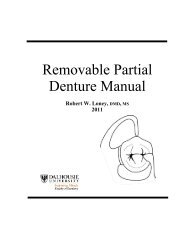Manuals_files/CD Manual 12.pdf - Removable Prosthodontics
Manuals_files/CD Manual 12.pdf - Removable Prosthodontics
Manuals_files/CD Manual 12.pdf - Removable Prosthodontics
Create successful ePaper yourself
Turn your PDF publications into a flip-book with our unique Google optimized e-Paper software.
Preliminary Edemtulous Impressions - 10<br />
13. Less gagging will occur, if the patient is lying down (tongue position avoids gagging)<br />
14. The clinician molds the vestibular areas by pulling on the cheeks and lips to activate<br />
the muscles and frena<br />
15. Support the tray during setting – do not leave the patient, or allow the patient to<br />
support the impression – if the tray moves during gelation, distortion will occur<br />
16. Remove with a sudden jerk (to avoid permanent deformation)<br />
17. Evaluate impression and, if it is acceptable, pour within 12 minutes<br />
18. Rinse the impression thoroughly with water, gently shake to remove excess water.<br />
Spray with disinfectant to coat all surfaces, and seal in a bag for ten minutes<br />
Possible Problems with Syringe Technique:<br />
1. Saliva contamination – vestibular material will appear separate from the tray material<br />
2. Insufficient material – lack of integrity between the syringed and tray material<br />
3. Omitting lubrication of the plunger may make it difficult to express the alginate<br />
4. Trapping tongue under the tray will result in underextension of the lingual vestibule<br />
5. Severe gaggers – the syringe technique involves a slight increase in intraoral<br />
manipulations which may be counter productive for these patients<br />
Diagnostic Casts<br />
Pouring a Model<br />
1. Weigh powder, measure water<br />
2. Vacuum mix (less time, stronger cast)<br />
3. Use a two pour technique<br />
4. Modulate speed of pouring by tilting back and forth or pressing the tray more firmly<br />
onto the vibrator<br />
5. Make sure the model is moist during trimming soak in slurry water, or soak with base<br />
of cast in water<br />
6. Casts should be a minimum of 12 mm (.5 inch) in thinnest part<br />
7. Separate the alginate impression from the stone cast after 45 minutes<br />
Trimming<br />
1. Trim the base on the model trimmer parallel to the residual ridges<br />
2. Leave the mucous membrane reflection intact for making a custom tray. Remove<br />
extensive areas of the cheek or lip reflection which create undercuts and which will<br />
make it difficult to make or remove the custom tray<br />
3. All anatomical surfaces should be included with minimum voids















